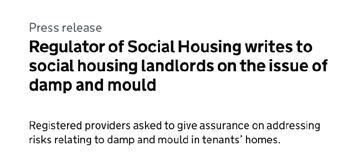
Housing Innovation Vivus Solutions: Putting Fabric First Back in The Spotlight Also In This Issue A New Dawn For Scotland: The State of Housing Post-Sturgeon
Vivus Solutions: Putting Fabric First Back in The Spotlight
Associations can’t forget the fundamentals of fabric first.
As a new dawn emerges for Scotland, and the vision for the future of housing post-Sturgeon is unveiling, Housing Industry Leaders explores what this means for the sector and Scotland.
In this issue, Housing Industry Leaders analyses how the sector can make changes to social infrastructure across the UK, how Liverpool City Council are reacting to being put in special measures, how Vivus Solutions are putting fabric first, and how to encourage more fire safety inspectors into the sector.
With a specific focus on how the social housing sector can expand its housing stock faster, Housing Industry Leaders dives into the most topical discussions and debates about the future of the housing industry.


housingindustryleaders.com
Floyd March
f.march@peloton-events.co.uk
P. 2
Contents
P.4
A New Dawn For Scotland: The State of Housing Post-Sturgeon
P.6
Latest Verdict on Liverpool City Council Special Measure Improvements
P.8
Housebuilding Activity Down Again: But is it Easing?
P.10
Vivus Solutions: Putting Fabric First Back in the Spotlight
P.12
2025 Future Homes Standard: Barratt to Build More Homes Offsite
P.14
How to Encourage More Fire Safety Inspectors Into the Sector
P.16
Putting People Before Policy: Will Tenant Engagement Increase?


P.18
How to Win More Bids in 2023
P.19
Previous Editions
P.20
Housing Cymru Event Highlight
Multimedia Editor
Floyd March
Multimedia Journalist
Chelsea Bailey
Graphic Designer
Edward Boustred
P. 3
A New Dawn For Scotland: The State
of Housing
Post-Sturgeon

Sending a shockwave through British politics, last month saw the unexpected resignation of Nicola Sturgeon, the longest-serving First Minister. As the dust settles, a clearer picture of how the future of Scottish housing will look is being painted, and Town Centre Living may be at the heart of it.
Town Centre Living (TCL) is a key policy aspiration for the Scottish Government, local authorities and a wide range of other public, private and third-sector bodies. It builds upon strong foundations of strategic place planning and supports key principles around inclusion, wellbeing and sustainability.
Speaking in the TCL report published late last month, it was stated: “The development of housing that brings more people to live within our town centres can have a major role in creating strong and sustainable places, as well as supporting key policy aims around active travel, affordable and independent living, walkable neighbourhoods, the wellbeing economy, net zero, and the re-use of existing built assets.”
Town centre living encapsulates the fact that improving social housing alone won’t bridge the class divide in the UK and help increase social mobility. It has been argued that: “TCL can underpin the resilience of many of Scotland’s places, but it needs to be done in a way that delivers the right homes, in the right places, for the right reasons.”
Sturgeon out - Town Centre Living in?
While under Sturgen’s reign as First Minister, there was limited TCL activity across Scotland and some towns where there has been little, or even no, new town centre housing development for a considerable time, there are hopes that the new FM will introduce new policies to address this.
The message is that turning policy into practice is complex but not impossible. “By harnessing the economic, demographic, well-being and net zero opportunities that TCL offers, we can deliver more homes at the heart of great places.”
As well as presenting the challenges and constraints, this report also presents some of the successes that places can learn from to support the delivery of new TCL proposals and also to improve current proposals – do more and do better.
TCLs fit existing policyso why minimal implementation?
Concerns over the failure to implement this across Scotland are further exacerbated when highlighting that the ideology behind them coincides with existing policy and legislation.
The report articulated this by explaining: “There is clear alignment and good strategic fit for more TCL developments to come forward. The national context supports the local agenda, with TCL almost invariably featuring in town/city centre strategies and local place plans.
P. 4
TCL is acknowledged as an important tool in delivering improved outcomes for communities: for the people who benefit from living in the houses, for the businesses who benefit from the residents’ spending power, and for the wider community, visitors and workers who enjoy a more active, vibrant and resilient town centre.
Push and pull factors creating polarised opinion
To gain a better understanding of the demand for TCL, SFT commissioned an analysis that identified a range of ‘push’ and ‘pull’ factors that influence people’s views around housing choice.
Push and pull factors:
• Proximity to places of work and study
• The quality of the physical environment and access to green spaces
• The range of services and facilities, including public transport choices
• Housing quality and choice, including cost, size, type and tenure
• Negative issues – for example, pollution, crime and perceptions of safety
While implementing TCLs across Scotland may be seen as the top priority for the next First Minister, there are significant project barriers to consider.

Funding gaps are high on the agenda, with a significant disparity in the distribution of funds to local authorities across Scotland. Further funds allocated for TCLs may be lacking due to a lack of evidence for demand, despite public opinion growing.
Time, cost and the process of obtaining consent for developments across the varying cities is a considerable barrier as authorities, many of which are already facing cuts to funding, will be looking to implement quicker and notably cheaper wins to help support housing.
The report addressed these concerns: “Whilst each town and the project will have its own unique set of circumstances, addressing these three barriers could have a material impact on the attractiveness of TCL, specifically for private sector owners, investors and developers.”
To incentivise private sector investment, the report recommended a three-step action plan to make an immediate impact and deliver long-term success for TCLs in Scotland.
Continue
Immediate Action Tackle the issues that can quickly and easily be addressed
Action
Medium-term
to investigate the issues that require a more detailed understanding in order to find an appropriate resolution
efforts to positively influence those issues that require a long-term approach to change P. 5
Longer-term Action Instigate
Latest Verdict on Liverpool City Council Special Measure Improvements
Issuing the third update on the progress made by Liverpool City Council since being put into special measures, Housing Industry Leaders investigates what improvements have been made and what are the continued risks moving forwards. In an open letter to the DLUHC, Commissioners for Liverpool City Council Mike Cunningham, Joanna Killian, Neil Gibson, Deborah McLaughlin & Stephen Hughes set out the update on the progress of the intervention in Liverpool City Council.
This report marked the halfway point of the intervention, intended from the outset to the last three years. The commissioners began the report by recapping the findings from the second report: “In our last report, we set out concerns that the Council had not correctly assessed the nature and scale of the improvements required and was therefore not making sufficient progress.”
Cautious optimism growing in Liverpool
They concluded that an expansion of the intervention, and the appointment of a Finance Commissioner, was necessary. Six months on from that report: “We believe that there is now cause for cautious optimism for the improvement journey of the Council. The leadership of the Council, at political and officer level, have shown grip and determination to improve at pace.”
Breaking down some of the improvements in more detail, the commissioners highlighted that: “Officers have developed credible options, at pace, to meet the significant budget gap. The Mayor and Cabinet have shown commendable political leadership to take the difficult decisions necessary to set a balanced budget.”
Additionally, they found that the Council has a more corporate approach to senior decision-making, with a robust forward look, and with silo-working now diminishing. The senior leadership team are committed to open communication with staff, and a new organisational structure has been agreed upon to improve capacity and capability, and progress is being made on recruitment.
Critical risk still in place
The budget-setting process for 2023/24 was the standout example of improved leadership. It was found that: “The interim Chief Executive and the interim S151 officer worked at pace with the corporate management team (CMT) to provide credible options being proposed to deal with the significant revenue funding gap. The Mayor and the Cabinet displayed political leadership to work with the Labour group to support difficult choices to secure a balanced budget.”
The commission was keen to highlight that challenges remain in implementing the budget, which will require further determined leadership.
While there is growing optimism for the future of LCC, and progress has been widely reported, there are significant risks to guard against. Many of these risks are natural products of a transformation process. For a Council on a rapid improvement journey, those changes often must happen concurrently.
P. 6
These include:
• 2023 will see new political leadership in LCC with all-out elections in May and the move away from the Elected Mayor model to Leader and Cabinet.
• Officer stability. There are still many interims in senior roles. Spring 2023 will see significant change at the top of the organisation, including a permanent Chief Executive and S151 officer.
• Budget decision-making and implementation, alongside a Councilwide transformation programme, will require careful management and corporate ownership across the organisation.
• The Intervention service areas still have a long way to go to meet the Commissioners’ criteria for a stable service.
• Culture change. Improvement at the Council is dependent on the genuine engagement and investment of staff.
• The leadership situation in Children’s Services is a risk for the Council. The Director of Children’s Services moved to another Council in early February.
As Liverpool City Council aims to get back on track and deliver for its citizens, the rest of 2023 will be one of the most challenging and potentially rewarding years in its history. With confidence from the commissioner’s growing, it is crucial that Liverpool City Council continues to make progress.

P. 7
Housebuilding Activity Down Again: But is it Easing?
Facing another difficult month, Purchasing Managers’ showed a continuation of the decline in housebuilding activity for the third consecutive month, reaching almost unprecedented levels.
Seeing one of the sharpest declines in a decade, February saw a continuation of the housebuilding trends for a third consecutive month.
Amid a ‘subdued’ housing market, the third drop was less severe than in January, according to the latest data, but still perpetuates the growing concerns of the housebuilding sector.
Housebuilding activity continues to fall
Through the index compiled for the Chartered Institute of Purchasing and Supply by S&P Global recorded, any figure below 50 represents a decline in workload for the sector. Falling 2.6% under this threshold, the figure for housebuilding activity was recorded at 47.4.
Coming below the critical 50 number for a third consecutive month is almost unprecedented. However, it has increased
in the 44.8 figure recorded in January, offering a slight hope that activity could increase to figures above 50.
The CIPS explained that the housing index encapsulated the: “subdued market conditions due to elevated interest rates, alongside cutbacks to new house building projects in anticipation of weaker demand.”
Despite this third consecutive drop, a more positive outlook is expected for the next monthly update as the group explained construction work as a whole picked up in the month, with total construction orders increasing at their fastest pace for nine months.

Wider construction showing positive signs as 2023 continues
Detailing this in the index the total activity rose from 48.4 to 54.6 monthon-month, which is the strongest rate for over a year, as the construction sector looks to catch up with missed deadlines due to the pandemic.
Although, upon further analysis of the figures, the dramatic rise in the statistics may be a bounce back from a disastrous set of statistics from the back end of 2022 and the beginning of 2023, which saw the worst recorded fall in activity since the first lockdown.
Tim Moore at S&P Global Market Intelligence said client confidence had been improved by “fading recession fears and an improving global economic outlook”.
C onstruction companies appear increasingly confident about the year ahead business outlook, with optimism rebounding strongly from the lows seen in the final quarter of 2022.
Tim Moore
P. 8
S&P Global Market Intelligence
Asset Management for the housing sector
The housing sector is facing significant challenges
Poor investment in Asset Management education and developing competency is part of the problem.
Professionals in the housing sector need to understand how to adopt a whole lifecycle approach to building, maintaining and disposing of housing stock.


Did you know?

Many of those managing portfolios of housing stock still don’t recognise themselves as part of the Asset Management profession.
Sector focus is often on maintaining housing assets for today, not managing for the long term.
Earlier adoption of good Asset Management practices could have avoided issues with today’s housing stock.



The recognition of good Asset Management practices is low in the housing sector compared to other asset-intensive sectors.
A lack of competency in Asset Management makes it impossible to deliver a robust Strategic Asset Management Plan (SAMP).
We offer a Certificate in Asset Management for the housing sector

The course covers:
◆ The principles and concepts of Asset Management in line with ISO 55000.
◆ The full syllabus of the IAM Certificate qualification. Created by Asset Wisdom with housing industry experts to educate and develop competency in Asset Management for the housing sector.
Find out more at asset-wisdom.com
The Experts in Asset Management Education and Learning
Vivus Solutions: Putting Fabric First Back in the Spotlight
Fabric first is a phrase that has been perpetuated into housing rhetoric, but as new technologies start to dominate the landscape of retrofit and decarbonisation, could we be losing touch with the fundamental principles of this approach?
Technology rollout has never been more important in the housing sector to demonstrate where issues arise in accommodation, especially when establishing damp and mould issues. However, only through a fabric first approach can the sector eradicate the issues at the heart of the problem. This can help save long-term costs for associations and help improve the lives of their tenants by removing damp and mould at the source.
Housing Industry Leaders spoke to Harry Cursham, Managing Director Vivus Solutions, about how essential maintaining a fabric first approach across Wales is and how Vivus has fabric first at its core.
Associations should utilise dry lime materials
Vivus Solutions Limited manufactures patented, pure air dry lime building materials. Focusing on two render materials, Vivus can offer Thermasec poulticing & insulating render base coats and Diffusec external protective & strong poulticing render top coats.
Speaking of the unique benefits of the Vivus dry lime building materials, Harry added: “They are recyclable, sustainable and environmentally friendly, with our materials producing 80% less CO2 than Portland Cement. As well as being fast setting, the elasticity prevents cracks and protects surrounding brick and stone.”
Always using the best possible ‘air lime’ and suitable aggregate to ensure the material actively removes moisture from the building, Vivus Solutions is heavily aligned with the fabric first requirements expressed across ORP documentation. Vivus differentiates itself from others in the market by actively balancing humidity to within the optimum, which also naturally balances temperature. Therefore, the building naturally controls temp & humidity and mould.
Vivus Solutions is heavily aligned with ORP objectives
The release of the Optimised Retrofit Programme 3 guidance stipulated that: “ORP is intended to act as proof of concept for approaches to both fabric and technology retrofit and establish a firm evidence base on which to develop our longer-term retrofit strategy. Our focus for ORP 3 will continue to be on optimising the thermal and energy efficiency of Welsh social homes.”
Harry explained that fabric first and technology will always go hand in hand, but prioritising fabric first will allow for technology to be deployed on a more practical scale and avoid using technology for technology’s sake.
“I think the fabric first is the most logical approach if you’re going to add technology to a building and make it more energy efficient. All associations should make the building work to its optimum before considering what technology to deploy.”
The problem is, and historically has always been up to now, what do you do to the fabric? The sector has seen many ambitious fabric first attempts underdeliver, which has caused a tendency to avoid fabric first because of the unintended and unexpected consequences.
P. 10
Fabric first not there to detract from technology
Harry expanded on this point and explained how it is essential that the business case for fabric first is continually built. “If Vivus can positively show that the solution works, we can prove fabric first is still the standard for the sector to follow.”

Successfully utilising a fabric first approach can allow associations to think about the long-term health of their stock rather than short-term wins, which will reduce maintenance and further retrofit costs.


Acknowledging fabric first is key to success; Taff Housing has been working in strong collaboration with Vivus to ensure their tenant's needs are met and their housing stock is fit for the future in line with the ORP.


Highlighting how a fabric first approach can offer long-term success for associations, Vivus offers a 25 year guarantee on all its products. Harry added, “We’ve got renders that are comfortably sitting there 27 years later. We are absolutely certain the renders we’re putting out are going to be strong in 100-plus years. If you keep up with any minimal maintenance, the housing stock will be improved from one solution.”
The need for one product, multiple solution offerings will be of growing importance to associations, since the announcement of new policy holding social landlords to account for the condition of their stock.
Rounding up, Harry said: “Fabric first is so key in so many ways beyond the reduction of technology. I think the reduction in maintenance because you’ve got the structure is a huge benefit. The house can operate to the high standards set by the central government without the need for expensive technology, offering a less invasive experience for tenants, who are all giving extremely positive feedback.”
P. 11
2025 Future Homes Standard: Barratt to Build More Homes Offsite
As the sector transitions to the 2025 future homes standard, industry-leading housebuilders Barratt has committed to building more homes off-site.
This commitment comes in the form of a £45m timber frame factory to boost housebuilding speeds while reducing its impact on the environment and meeting the 2025 Future Homes Standard.
The new factory will allow Barratt to reach its ambitious commitment to become carbon neutral by 2030 and tackle the mission to have 30% of its homes to be developed through modern methods of construction.
New facility will open in Derby
Relocating to Derby, the newly bought timber manufacturer Oregon will move from Burton-upon-Trent to the brand new 186,000-square-foot facility to boost house-building growth.
This comes at an invaluable time for the sector, as statistics show housebuilding activity fell for the third consecutive month. Barratt will be looking to showcase the best ways to boost housebuilding while decarbonising in the process.
With a re-estimated housing projection of around 17,000 new homes in 2023, Barratt will be looking to extend the amount built with timber frames from the 3,700 developed in 2022.
It will be interesting to see how scalable this construction method proves to be, especially with the opening of the new facility in Derby. Providing the business case for MMC has been a difficult slog for the housing sector, but there is wide optimism that this could be a real turning point.
Timber frame systems can cut time and costs
Using a timber frame system enabled it to cut build time on developments by an average of five weeks compared to the traditional masonry method last year alone. This is anticipated to be improved even further, a vital aspect of easing the housing crisis across the UK.
David Thomas, chief executive of Barratt Developments, said: “Increasing our use of modern methods of construction, including timber frames, is a key part of Barratt’s road to net zero carbon. He added that he wants Barratt to be the “leading national sustainable housebuilder,” and to achieve this, they are looking to work with suppliers and challenge pre-existing methods of construction in order to save costs, time and the planet.
The facility itself will operate at an EPC rating of A and has recently received a BREEAM very good rating, with Bowmer & Kirkland announced as the main contractor for the project.
Peter Wade is excited about the future of MMC
Peter Wade, joint managing director at Oregon, said: “Infinity Park in Derby will become our new base to support Barratt’s commitment as a leader in sustainable housebuilding at scale. This new state-of-the-art facility will support our long-term goals to increase the use of modern methods of construction off-site to reduce Barratt’s carbon footprint.”
With the Future Homes Standard will require all home construction to produce 75% to 80% fewer carbon emissions than homes built under the current Building Regulations, this type of MMC is likely to become the norm as we push for net zero.
P. 12

P. 13
How to Encourage More Fire Safety Inspectors Into the Sector
Responding to the Grenfell fire inquiry, where John Hoban cited pressures by staffing levels being reduced from 12 to five led to serious errors, a £42m funding package will deliver training and recruitment for more than 200 fire and building control inspectors. With the funds being delivered through the DLUHC, £16.5m has been designated to the Local Authority Building Control, while £26m has been assigned to the National Fire Chiefs Council for recruitment and training.
This funding is expected to produce 110 new building control inspectors and 111 new fire protection officers to be recruited and trained over the next three years to offer a lessons-learned approach to the Grenfell inquiry.
Gradual decline in control inspectors has led to monumental failings
Training will specifically focus on high-rise and traditional buildings, and recruitment will attempt to rectify the 27% fall in building control inspectors employed in England by local authorities.
Equating to roughly 1400 inspectors, the funding aims to address concerns brought up in the Grenfell fire inquiry back in 2020, where John Hoban, responsible for the signing off the cladding that proved deadly, claimed the serious errors were partly due to the pressure created by the number of staff at the council being reduced from 12 to five.
The recruits will be directly responsible for overseeing safety standards across the design, construction and management of high risk buildings to ensure any
defects or incorrect safety protocols will be stamped out across the value chain of housebuilding.
Lee Rowley, the Minister for Building Safety, said: “The government is delivering important reforms under the Building Safety Act, including introducing the new Building Safety Regulator to oversee building safety and performance.”
With public funding being cut across multiple areas of the housing sector, there has been a significant downturn in the number of Fire Service Enforcement Officers since 2010. Between 2011 and 2017, a Guardian investigation found that there had been a loss of 244 officers, with this number expected to have grown significantly.
New regulators will have increased powers
Peter Baker, the Chief Inspector of Buildings at the Health and Safety Executive, said: “Local authority and fire and rescue services are vital to the delivery of the new safety regime for higher-risk residential buildings.
Welcome the work to quickly partners can deliver their important of the new regime in keeping residents
Peter Baker
Chief Inspector of Buildings Health and Safety Executive
This taxpayer funding will give additional resources to local regulators who will support the work of the regulator in making buildings safer.
P. 14
Lee Rowley Minister for Building Safety
Adding to this, Lorna Stimpson, Chief Executive of LABC, a group which represents local authority building control staff as well as providing training and certification services, said: “We are delighted to have secured this funding to provide much-needed additional resources for our local authority members in England.
“We welcome the role that local authority building control will have as part of the new Building Safety Regulator’s multi-disciplinary teams and in helping to implement the reforms recommended by Dame Judith Hackitt.”
Focusing on the new regime, there will be an updated Building Safety Regulatory policy in the Health and Safety Executive. Building control inspectors, fire inspectors, and fire engineers will be the local partner regulators.
Increasing the powers that the regulator will have, they will be responsible across the value chain and have more say on how buildings should be constructed and safely maintained.

P. 15
increase capability and capacity so our regulatory important roles. Our common goal is ensuring the success residents safe in their homes, now and in the future.
Putting People Before Policy: Will Tenant Engagement Increase?
Ensuring that people are at the heart of housing policy, social tenants are getting unprecedented opportunities to scrutinise landlord’s strategies and policies under new proposals due to be finalised by April 2023.
Looking to revise the ways in which the Regulator of Social Housing operates to increase the level of involvement from tenants and improve overall tenant engagement.
The UK government say this will give more power to social housing residents to hold landlords to account.
Section 197 will allow changes to be made
These changes can be implemented under section 197 of the 2008 Act, which gives the Secretary of State the power to direct the Regulator of Social Housing (‘the Regulator’) in relation to specific matters. Once issued, the Regulator must comply with the direction. They propose to use this power to:
(a) Revoke the ‘Tenant involvement and empowerment and ’Mutual exchange’ paragraphs of the Directions on Regulatory Standards made by the Secretary of State on 1 March 2012; and
(b) Direct the Regulator to set revised regulatory standards (and the content of those standards) on tenant
involvement and mutual exchange and to have regard to specified objectives when setting the tenant involvement standard.
These directions will apply to the social housing stock of all registered providers of social housing, unless specifically exempted. The term ‘registered providers’ encompasses:

• Private registered providers (including housing associations)
• Local authority registered providers (i.e. local authorities with social housing)
In a statement, a spokesperson explained: “The government has committed to implementing a proactive consumer regulatory regime for social housing. This forms part of wider changes, outlined in the Social Housing White Paper, to ensure tenants are fully protected, have decent quality homes and are treated with fairness and respect.”
New direction for the regulator to be implemented
The Secretary of State has the power to direct the Regulator on certain aspects of its regulatory standard. This consultation proposes revoking the ‘Tenant involvement and empowerment’ and ‘Mutual exchange’ paragraphs of the Directions on Regulatory Standards made by the Secretary of State on 1 March 2012 and issuing new directions relating to tenant involvement and mutual exchange.
P. 16
Additionally, they currently have powers of direction relating to the quality of accommodation, tenancy and rent, which will not be consulted on at this stage. The rent direction was recently consulted on, given the need to provide certainty on rent levels as quickly as possible.
The government says it is committed to reviewing the Decent Homes Standard and plans to review the direction on the quality of accommodation alongside any changes to the Decent Homes Standard. The tenancy standard will be revised alongside any changes to Assured Shorthold Tenancies made through the Renters’ Reform Bill.

Tenants at the heart of new policy and services
The Social Housing Regulation Bill introduces two new powers of direction: provision of information to tenants and competency and conduct. Subject to Royal Assent, they will direct on these in due course.
The new directions include a number of small but important changes to support the smooth implementation of the new consumer regime. Subject to the outcome of this consultation, they intend to issue the new directions to the Regulator in spring 2023.
Once issued formally, the directions will be binding on the Regulator. The Regulator will subsequently conduct a statutory consultation with tenants, providers and other stakeholders on its revision of consumer standards for registered providers of social housing (‘registered providers’). As such, these directions may have an impact on the revision of standards which will affect registered providers and their social housing tenants. These regulatory changes support the overall reform objectives, as set out in the Bill impact assessment: to facilitate a new, proactive approach to consumer regulation so providers of social housing can be effectively held to account for the services they provide to tenants.
The proposed directions have no predetermined end date, but they may be subject to change or revision. Any further amendments or changes will require further consultation.
Overall, at the heart of the new directions from the Secretary of State for housing will include a requirement for social landlords to give tenants the opportunity to “scrutinise” strategies, policies and services.
How to Win More Bids in 2023
Q: With SMEs fighting larger companies for the same contracts, how can SMEs stand out from the crowd if they don’t have the same experience and success stories?
Andrew: What I'd say is to take a look at the procurement strategy of the buying organisation. Often they'll have a published procurement strategy. The UK government, once, for example, said they want to see 50% of public sector contracts being delivered by SMEs there.
But SMEs themselves want to get contracts in their own right. So what I say is start going for the smaller contracts, prove your evidence rather than maybe going for a big contract straight away. It's also important that you manage your relationships.
I would suggest going for some of the opportunities for work from the energy companies because that is a way as a way of getting work, perhaps without the need to offer a very formal tender process.
Andrew Morrison Founder & BD Director, AM Bid

 Jim Williams Commercial Director, World Kinect Energy Services
Jim Williams Commercial Director, World Kinect Energy Services
Jim: My tip would be as Andrew said, and start small. Look to build on your existing experiences, speak with your clients as well and get as much information to build on your processes and your accreditations. Always work very closely with your existing clients to understand the value that you bring.

Additionally, get some support as well and make sure that you're bidding the right kind of bids to suit the financial thresholds of some of these bids. If you're returning over £1,000,000 you shouldn’t be bidding on £1,000,000 contracts. It's very difficult for you then to meet the financial thresholds. So again, just work on that and start small, be very close with your existing customers and get as much evidence as you can and build on the success that you've done in the private sector and bring it into the public sector.

Watch the Full Webinar P. 18
Cymru
Mercure Holland House Hotel, Cardiff
11 July 2023
KEYNOTE SPEAKER
Rt Hon Mark Drakeford MS


First Minister of Wales
Building on the initial phases of the Optimised RetroFit Programme (ORP), this one day conference will explore how a whole house, pragmatic approach to decarbonising existing homes is essential across Wales.

Setting out core objectives of the ORP, Rt Hon Mark Drakeford MS will explore the core themes of the programme, including affordable warmth decarbonisation goals and understanding the best pathway to better energy efficiency for social homes and their residents.
The day will consist of a series of keynote speeches, panel discussions and technical seminars, with an exhibition zone running throughout the day.
#HousingCymru
#HousingLeaders
housingindustryleaders.com
P. 19
Covering all Angles of the Housing Industry
11 July 2023
Mercure Holland House Hotel, Cardiff

Why Housing Industry Leaders?
Setting out core objectives of the ORP, Rt Hon Mark Drakeford MS will explore the core themes of the programme, including affordable warmth decarbonisation goals and understanding the best pathway to better energy efficiency for social homes and their residents.
The day will consist of a series of keynote speeches, panel discussions and technical seminars, with an exhibition zone running throughout the day.
Join us on 11 July 2023 at Mercure Holland House Hotel, Wales, where housing leaders, experts and innovators will be discussing what is needed right now to drive meaningful change and create communities for the future.
Join the conversation #HousingLeaders




























 Jim Williams Commercial Director, World Kinect Energy Services
Jim Williams Commercial Director, World Kinect Energy Services






